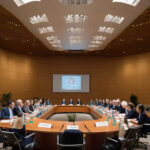In a bold move demonstrating its commitment to innovation and collaboration, Starlink is set to conduct a pivotal test in Romania. This initiative seeks to evaluate the feasibility of relaxed power flux density (EPFD) limits for its non-geostationary satellite (NGSO) systems, a significant step towards enhancing satellite operational capacity. The potential outcomes of this test could redefine how satellite networks coexist and operate alongside traditional geostationary satellite systems.
In partnership with Romania’s National Authority for Communications Administration and Regulation (ANCOM) and the Ministry of National Defence, this project aims to investigate if Starlink’s satellites can operate without causing harmful interference to established geostationary satellite (GSO) networks. The implications of this test are considerable, as successful results could pave the way for Starlink to increase its capacity by up to eight times the current limits set by the International Telecommunication Union (ITU).
The existing EPFD limits have their roots in regulations established 25 years ago, designed to minimize interference among satellite services. These rules largely reflect the technological capabilities of the time and may now be outdated. Many experts believe that advancements in technology render these existing limits overly restrictive. Recognizing this, ANCOM is spearheading the testing to provide invaluable insights that will contribute to ongoing ITU studies.
The core of the test consists of exceeding these existing EPFD limits within a designated area for a minimum duration of six months. During this time, SpaceX—Starlink’s parent company—will install specialized equipment to monitor signal and interference levels. The criteria for protection are rigorous, allowing only a 10% increase in aggregate service unavailability and a mere 3% increase in individual service unavailability. Data collected from this real-world trial will be essential in demonstrating the potential for efficient operations of NGSO networks without compromising the functionality of GSO systems.
Moreover, the findings from this testing campaign will be critical in discussions at ITU meetings, showcasing how interoperable and efficient NGSO operations can coexist with GSO networks. This not only highlights Starlink’s technological capabilities but also reflects Romania’s commitment to establishing a regulatory framework that harmonizes and balances the interests of both types of satellite systems.
The importance of this test extends beyond technical evaluations. It represents a proactive effort by Romania to engage with international regulations that govern satellite operations, particularly as the issue of satellite interference becomes more pressing. The ITU is preparing to review EPFD limits in the upcoming World Radiocommunication Conference (WRC-27). Romania’s active involvement puts it in a position to advocate for a balanced approach that acknowledges the transformative potential of NGSO networks in enhancing global connectivity.
In today’s connected world, where access to satellite-based internet services is becoming increasingly vital, the implications of such testing cannot be understated. As broadband connectivity becomes a crucial utility, particularly in remote areas where traditional infrastructure may be lacking, enhancing satellite operational capabilities will serve to bridge digital divides and promote inclusive access to information and services.
In conclusion, Starlink’s initiative in Romania is a significant step towards reevaluating regulatory frameworks governing satellite operations. It underscores the importance of innovation in telecommunications and the necessity for regulations that reflect current technological capabilities. The successful outcome of this test could not only lead to a significant leap in connectivity for underserved regions but also set a precedent for future collaborations between regulatory bodies and technology providers in the evolving landscape of satellite communications.












